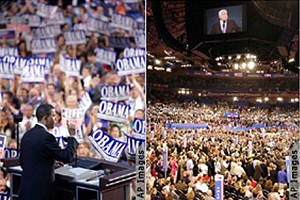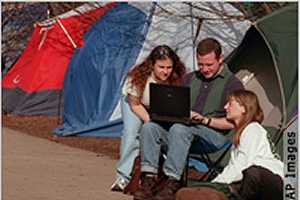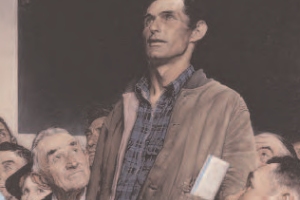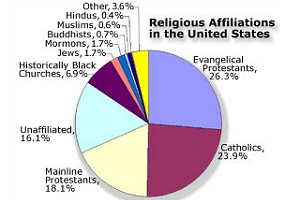America in context
FAQ on Political Conventions

The processes of the political national conventions have evolved over more than a century, but the purpose has remained the same -- to nominate presidential candidates and lay out goals and party priorities.
The first political convention was held in 1831 when the Anti-Mason party met in a Baltimore saloon to choose candidates and write a platform on which they would run. The next year, the Democrats met in the same saloon to select their nominees. Since then, the major parties and most minor parties have held national nominating conventions, attended by state delegates, to choose their presidential and vice presidential candidates and to agree on policy positions.
In conventions held during the 19th century and most of the 20th, the national conventions, even though attended by many of the party faithful, were controlled by state party leaders. These political "bosses" had used their influence to hand pick their states convention delegates who would help select the presidential nominee. Opponents of that system demanded reforms to permit ordinary voters to select convention delegates. This led to the establishment of primary elections. In 1916, more than half the states held presidential primaries. The primary system declined during World War I but its popularity rose again after World War II.
Early political conventions were colorful, contentious and filled with lengthy speeches and debates, but much business was also conducted by party leaders and key supporters in private meetings that became known as “smoky back rooms” -- eventually an American political cliché.
Because primaries and caucuses now determine for whom delegates will vote, the presidential nominee usually is known months before the convention, the nomination vote at convention is a formality, but remains an important one. It serves as an official introduction of a party’s nominee, demonstrates party unity and marks the beginning of the general election campaign.
Originally, presidential candidates stayed away from conventions, but Franklin D. Roosevelt broke that tradition in 1932. At today’s conventions, a speech from the nominee is considered the highlight of the meeting.
When and where are the 2008 conventions?
Democrats will convene August 25 to 28 in Denver. Republicans will gather in Minnesota’s twin cities of Minneapolis and St. Paul September 1 to 4. More than 45,000 people -- including party members, delegates, journalists, security forces and other service providers -- are expected to descend on each of these cities and bring them millions of dollars in revenue.
John McCain’s speech is broadcast through the convention hall at the Republican National Convention in New York in 2004.
What is a typical convention schedule?
The exact schedule varies each year and with each party. The introduction of television altered many convention traditions -- parties now schedule their biggest events and most prominent speakers during television’s prime viewing hours (8 p.m. to 11 p.m. EDT).
Throughout the week, leaders and delegates hold informal gatherings or official committee meetings behind the scenes. For the more formal convention activities, plans often are not final until the last minute, but a rough schedule of what is likely to occur follows:
Day 1: The convention is called to order by the party chair, and important local leaders deliver welcoming speeches. Rules committees meet to finalize procedural issues such as the credentialing delegates. Important party members, such as the current president or those identified as “rising stars” in the party give speeches in the evening. One of the rising stars speaking at the Democratic National Convention in 2004 was Senate candidate Barack Obama.
Day 2: Routine committee business continues. Party leaders gather to make final the organization’s platform, a statement of its political philosophies and goals for the next four years. Platforms typically are drafted by a committee in advance of the convention but that draft is open for debate and revision at the convention. In 2008, Republicans are asking party members to share their views online. More speeches will be given in the evening.
Day 3: Occasionally, platform debate will spill over to this day, but the key event is the formal nomination of the presidential candidate. A party member makes the motion to nominate; another delegate seconds the motion; then the voting process begins as each state delegation is called to cast its votes. Because most delegates’ votes are bound (or pledged) to a specific candidate based on the results of primary or caucuses, the outcome of the voting rarely is a surprise. In recent years, the nominee choice for a running mate also has spoken in the evening.
Day 4: The vice presidential candidate is formally nominated. In the evening, the culmination of the past four days’ activities is the acceptance speech by the presidential nominee. For the first time since 1960, a presidential nominee has chosen not to give his acceptance speech from the convention hall. Instead, Barack Obama plans to speak from a nearby Denver football stadium that will hold a much larger crowd than the convention site.
Is there anything different about the 2008 conventions?
Both parties have taken countless measures to make these conventions the greenest political gatherings in history.
There also will be more bloggers covering the convention than ever before, and a record number of media organizations plan to webcast from the convention halls. For the first time, the proceedings of the Democratic National Convention will be simulcast in Spanish.
For more information, see the parties’ official Web sites: Democratic National Convention and Republican National Convention.
Recently on America in context
For Many Americans, Hard Work Is Badge of Honor
 Americans generally work more hours and take fewer vacations than workers in other advanced economies. But are they enjoying life less?
Americans generally work more hours and take fewer vacations than workers in other advanced economies. But are they enjoying life less?
John Updike Explores How Art Mirrors America’s Soul
 John Updike, a two-time Pulitzer Prize-winning author whose prolific output of novels, short stories, poems and essays has made him one of the most celebrated American writers now living, is perhaps best known as a chronicler of life in America’s small towns and affluent suburbs. As such, he is a longtime observer of his nation’s quirks, customs and tribal rituals, and an interpreter of a broad cultural landscape that defines the United States as surely as its geography does.
John Updike, a two-time Pulitzer Prize-winning author whose prolific output of novels, short stories, poems and essays has made him one of the most celebrated American writers now living, is perhaps best known as a chronicler of life in America’s small towns and affluent suburbs. As such, he is a longtime observer of his nation’s quirks, customs and tribal rituals, and an interpreter of a broad cultural landscape that defines the United States as surely as its geography does.
U.S. Religious Landscape Is Marked by Diversity and Change
 Religious affiliation among U.S. residents best can be described as "diverse and extremely fluid," according to a new poll conducted by the Pew Forum on Religion and Public Life.
Religious affiliation among U.S. residents best can be described as "diverse and extremely fluid," according to a new poll conducted by the Pew Forum on Religion and Public Life.